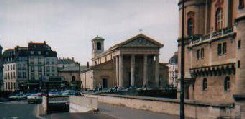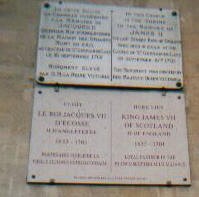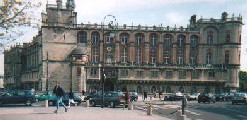St-Germain-en-Laye
Vincent de Paul and the French Court
During the latter part of his life, Vincent de Paul had an association with the French Royal Court. The association with Louis XIII probably began in 1636 with the first known interview between Vincent and Louis at Senlis, when Vincent was asked to send missioners to the army.
According to the author Abelly, Vincent made the journey to the army's general headquarters in Senlis to offer the king his services and those of the Congregation of the Mission.
Then, in 1638, on the orders of Louis, some Priests of the Congregation of the Mission were part of a group organised by the Tuesday Conferences to give a Mission to the Court at St-Germain-en-Laye, just west of Paris. It was here that the Missioners came in contact with the Court - with Louis XIII and the Queen, Anne of Austria. Louis himself spoke in defence of the preaching of the Missioners as they 'addressed' some of the vices of the Courtiers. Thereafter, Vincent often spoke of St-Germain-en-Laye in regard to Missions there, and in referring to both the Ladies of Charity and the Daughters of Charity.
Vincent, Anne of Austria and the Council of Conscience
Vincent became a personal adviser to Queen Anne of Austria, and regularly visited her at her pavillon at the Val de Grace (1, Place Alphonse-Laveran, 5th Arrondissement, Paris) - a place to which she frequently retreated to escape from the pressures of the Court.
In 1643, Vincent was asked to assist King Louis XIII on his deathbed. Louis spent his last days at St-Germain-en-Laye and died there. From his bed, Louis is reported to have looked across the countryside to the spires of Saint Denis and said he would be 'spending a long time there' - Saint Denis being where he would be buried. After Louis' death, Anne of Austria became the Queen Regent for her son Louis XIV (later known as the 'Sun King') who was only a few years old when his father died. Anne set up a body known as the Council of Conscience to advise her on appointments of Bishops, and other Church matters - and made Vincent de Paul a member of this Council. Through this Council, Vincent was able to have a huge influence for good on appointments to the Episcopate in France over a period of a number of years. His presence on the Council of Conscience also made him a target for the jibes of Cardinal Mazarin.
Royal Chaplaincies and Consequences
After Vincent de Paul's death, the confreres of the Congregation of the Mission took on Royal Chaplaincies at Fontainbleau, Versailles, Les Invalides, Saint-Cloud, Saint Cyr, and even London, works which Vincent himself had resisted despite pressure from the Court. These foundations were accepted during the terms of Fr René Alméras CM and Fr Edmond Jolly CM as Superior General of the Congregation. Such works continued till the French Revolution in the time of Louis XVI, and would have contributed to the deaths of a number of confreres during the Revolution as by then the connection of the Vincentians with the French Court was still apparent.
An English Connection
For those interested in English History, James II of England (James VII of Scotland), the last of the Stuart Kings, was buried in the Parish Church at St-Germain-en-Laye. After fleeing England, James II had been given refuge by his cousin, King Louis XIV of France (James II's mother, Henriette Marie, was the sister of Louis XIII, Louis XIV's father). The Stuarts had other strong French connections - Mary Queen of Scots, educated in France and married (her first marriage) to François II of France (brother of Marguérite de Valois), was the daughter of Mary of Guise. The Guise Family was one of the very Catholic Families of France.It is also interesting to note that, at the time of James II's demise, French Vincentians were chaplains to the Royal Court in London! James II had endeavoured to emulate his cousin Louis XIV, not only in regard to being an absolute ruler, but also in regard to having the Church present at Court in the form of Chaplains.


St-Germain-en-Laye can be reached by rail from Paris using Line A1 of the RER.
FURTHER RESOURCES
WEB LINK(S)
Saint-Germain-en-Laye: le site officiel, Official Site of Saint-Germain-en-Laye
IMAGES
Château de Saint-Germain-en-Laye, Southwest aspect of Château
Château de Saint-Germain-en-Laye, Etching by Israël Silvestre (1621-1691)
Saint-Germain-en-Laye Map, Map of St-Germain-en-Laye by Georges Boissaye du Bocage, 17th century



